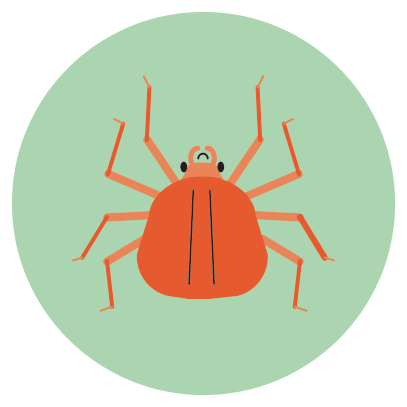TROUBLESHOOTING
SPIDER MITES
SPIDER MITES
WHAT TO LOOK FOR:
Spider mites look just like their name implies — very very tiny spiders. They only grow to about 1mm, about the size of the period at the end of this sentence. Red, white, tan or black, spider mites have eight legs which makes them an arachnid rather than an insect. Because they are so small they can be hard to spot unless you have a particularly bad infestation.
Like many other arachnids, spider mites actually do have (very tiny!) webs. The webs are generally easier to spot than the mites themselves, as they like to hide on the underside of leaves. Watch for tiny spider webs around the underside of leaves, as well as around joints. This is where they protect their eggs.
HOW IT HURTS:
Spider mites feed on plant tissue and sap. They bite into the leaves and suck out the chlorophyl, stealing nutrients from the plant. Over time, small spots will form. If left untreated, the whole leaf may eventually turn yellow and die. If spider mites are on several leaves, this can be a big problem! Damaged leaves are also weakened, making them susceptible to disease.
HOW TO HELP:
It is not recommended to use synthetic or harmful pesticides — especially inside! You don’t want those kinds of chemicals on the food you eat, or to breathe them in if you spray inside your home. Outside, pesticides (including organic ones) can harm beneficial insects such as bees, so it’s best to use sparingly — or try to find other methods.
Don’t under-water:
Spider mites thrive in overly dry conditions. It can help to keep plants moist (not soggy!)Spray them off with water:
One of the easiest ways to eliminate spider mites is to spray them off of the plant with water. This is easiest to do outside with a hose, but you could carefully attempt this in your kitchen sink if you have a strong sprayer. While a fairly strong spray will be needed to dislodge the spider mites, don’t spray so strongly that it harms the plant.Use neem oil:
Neem oil is a naturally occurring pesticide created from the seeds of the neem tree. It can be strong smelling and would be better for outside applications. You may need to re-apply if your plant is outside and has been rained on.Use beneficial bugs:
If your plants are growing outside, you can introduce or purchase beneficial bugs that like to eat spider mites. One such bug is the common ladybug. Just place the package of ladybugs at the base of the infested plants in the evening, ensuring that you’ve sprayed a bit of water on the plant before you open the package. The ladybugs will seek out food and water once they leave their container, and if it’s not available, they’ll fly away before they have time to munch on the spider mite population.Use rubbing alcohol:
Soak a cotton swab with rubbing alcohol and dab it under the leaves that are infested with spider mites.

